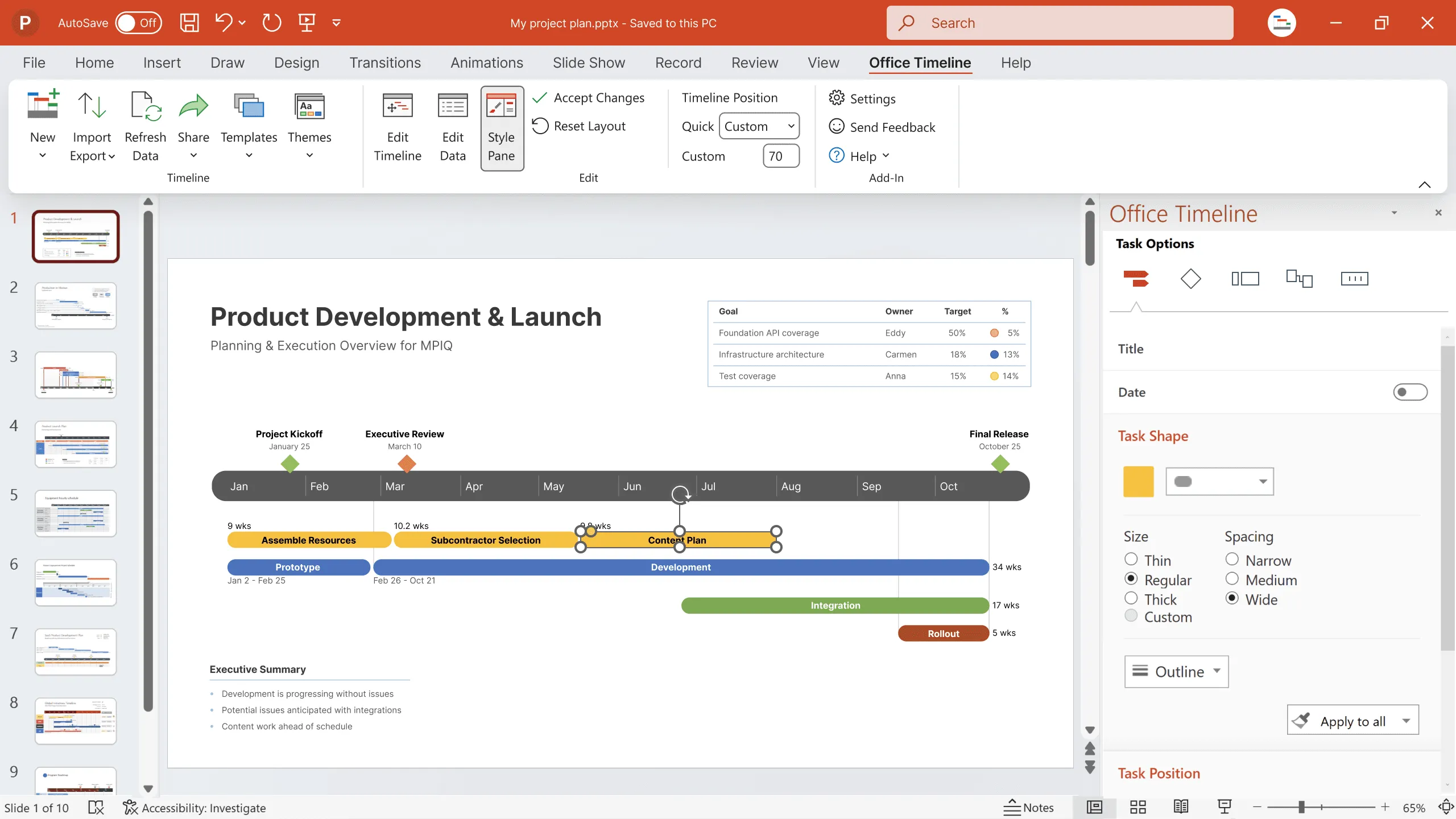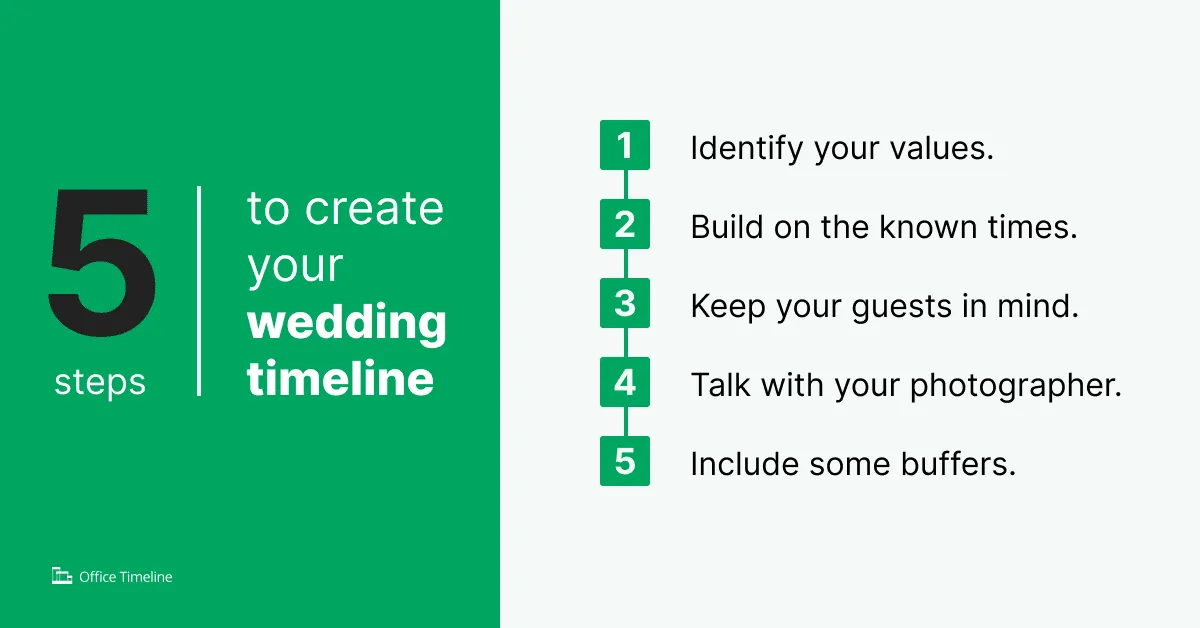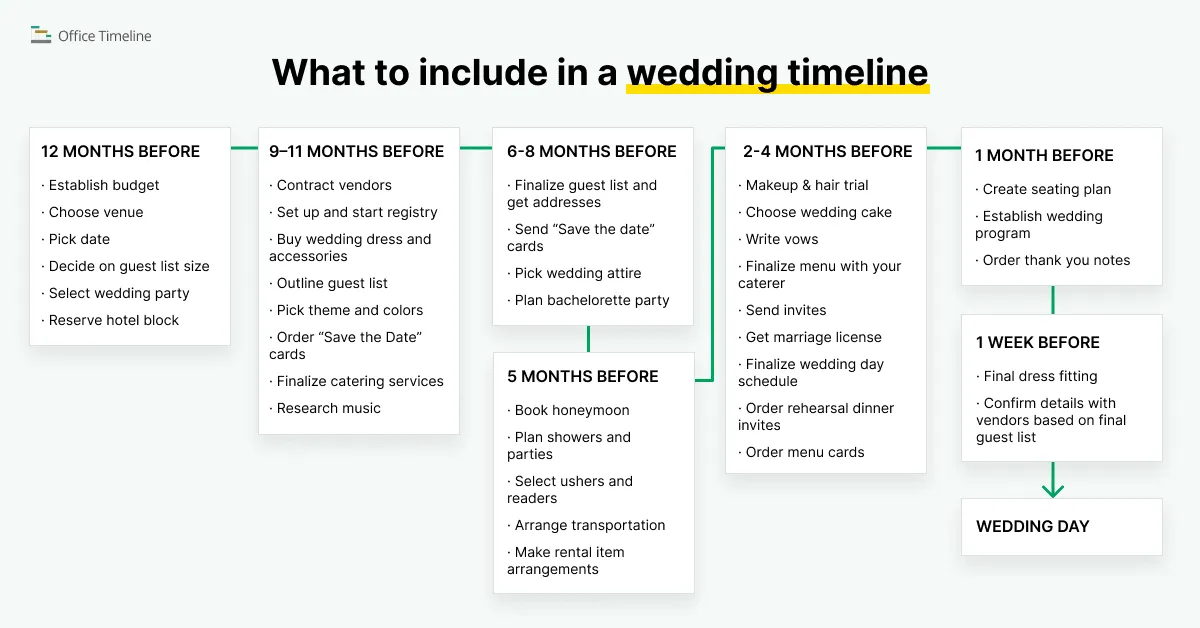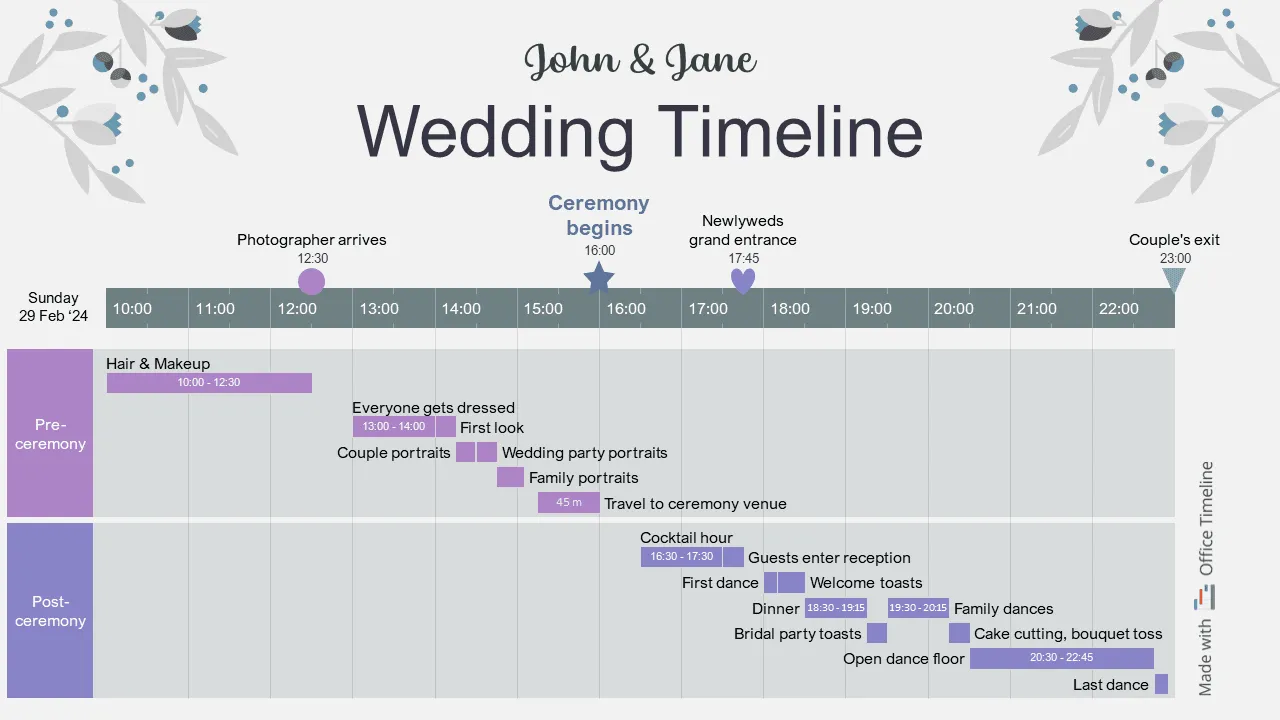How to create the perfect wedding timeline
Craft the perfect wedding day with our ultimate timeline guide! Stay stress-free and organized with expert tips, FAQs, and a customizable template. Ensure every moment is unforgettable on your special day.
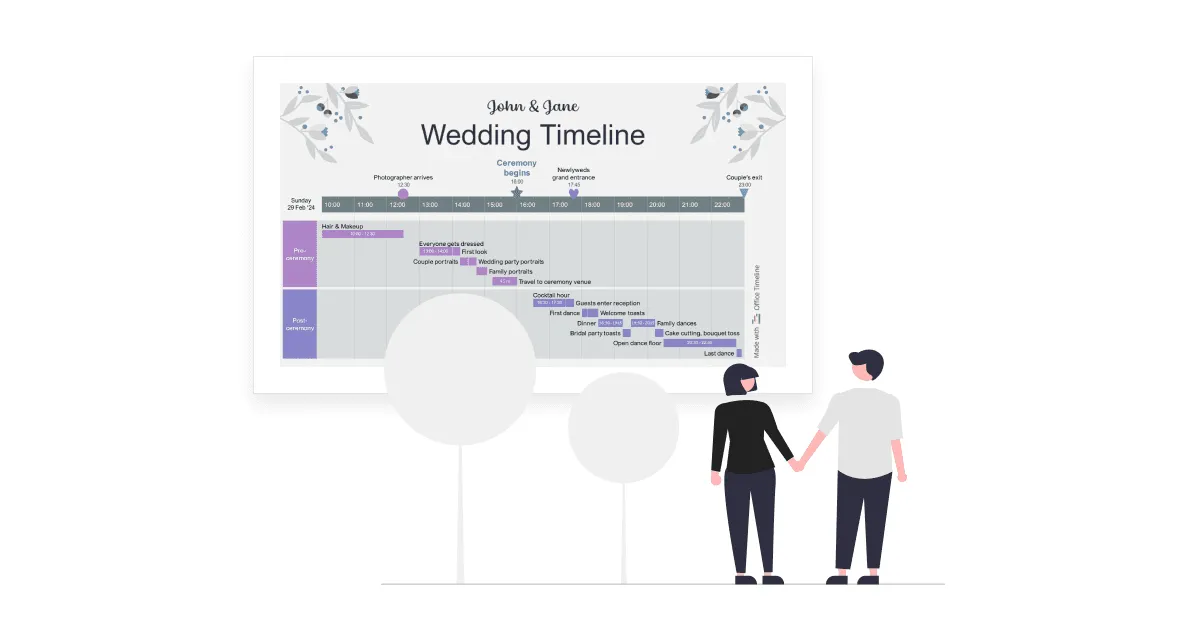
When you’ve decided it’s time to take the big step to the altar, nothing will ensure that better than a well-designed wedding day timeline. Planning ahead and breaking down your entire wedding day into an organized schedule will allow you to keep everything on track and enjoy your big day to the fullest.
The preparation process can become very stressful, so we’ve put together here a range of resources to assist you along the way. Apart from useful wedding timeline tips and answers to the most commonly asked questions on the topic, the present blog post also provides you with a stylish wedding day timeline template that you can quickly edit and update with your specifics.
We know it’s your special event and it’s unique, so our pre-formatted sample is offered just as a guide.
How to outline your wedding timeline in 5 steps
Follow these main steps in order to work out the timeline of your wedding:
1. Identify your values.
When you think of your wedding day, what prevailing aspect comes to the forefront? Do you imagine it as a big, gourmet banquet? Do you want to stand out in terms of music arrangements? Are you planning to dance the night away at your reception?
Try to pinpoint the parts of your wedding that you truly value, write them down, and start working your timeline around that big picture.
2. Build on the times you already know.
Before you proceed to filling out the timeline with distinctive sections, focus on the time slots you already know, such as the start of the ceremony, reception, and the end time. Once these important milestones are fleshed out, it will become much easier for you to build the schedule around them.
3. Define the important events/activities of the day with your guests in mind.
At this point, you need to decide on things such as:
- whether you want a first look before the ceremony – this way, you can have a family, bridal or formal couple picture session before, which will give you more time with your guests after the ceremony.
- the type of ceremony you want to have (if it’s traditional, the religious service will add to the total duration of your timeline; if it’s modern, then you will be dealing with a typically 15-20-minute-long ceremony).
- how to keep the action going and avoid long periods of no activity – as a suggestion, you may want to offer the guests a fun cocktail hour while you and the spouse have your bridal photos taken or ask your Best Man and Maid of Honor to have hilarious and heartfelt toasts while cake is served.
4. Talk with your photographer.
Always collaborate with them to establish the best times for photography coverage. Decide together which details you want them to capture, how you can group guests for collective shots and how much extra time they need before dinner/reception to photograph the guests.
5. Include some buffers to the time slots that you have initially carved out.
The last thing you want on your big day is to find out that you are short on time. Thus, plan more time than the hair & makeup artist tells you, consider details like your type of wedding dress (is it lace-up or has a lot of buttons?), ceremony and reception venues (are they the same or at different locations?) etc.
What should a wedding timeline include?
Here are the main elements that you need to plan for and include in your wedding timeline:
12 months before
- Establish budget
- Choose venue
- Pick date
- Decide on guest list size
- Select wedding party
- Reserve hotel block
9–11 months before
- Contract vendors (DJ, photographer, officiant, florist)
- Set up and start registry
- Buy wedding dress and accessories
- Outline guest list
- Pick theme and colors
- Order “Save the Date” cards
- Finalize catering services
- Research music
6-8 months before
- Finalize guest list and get addresses
- Send “Save the date” cards
- Pick wedding attire
- Plan bachelorette party
5 months before
- Book honeymoon
- Plan showers and parties
- Select ushers and readers
- Arrange transportation
- Make rental item arrangements (chairs, tables)
2-4 months before
- Makeup & hair trial
- Choose wedding cake
- Write vows
- Finalize menu with your caterer
- Send invites
- Get marriage license
- Finalize wedding day schedule
- Order rehearsal dinner invites
- Order menu cards
- Order wedding party gifts
1 month before
- Create seating plan
- Establish wedding program
- Order thank you notes
1 week before
- Final dress fitting
- Confirm details with vendors based on final guest list
Check out this quick visual overview that you can download and use to keep your planning on track.
Setting up your wedding day timeline
Here is how you can create an effective wedding day timeline:
- Start by using your ceremony time as a reference point.
- Make a list of all the events (getting ready, photo sessions, cocktail hour, first dance etc.) that need to happen before and after the ceremony.
- Determine the duration of each of the events listed at Step 2.
- Arrange the events in order and plot your wedding day agenda accordingly.
- Distribute your timeline to the vendors (caterer, photographer, DJ or band leader, hair stylist and makeup artists, wedding planner or event manager etc.) up to 1 week before your wedding.
- To finish things off, use our sample wedding day timeline as a model.
Free wedding day timeline template
Given that every wedding is different, the timeline template below is offered just as a guide. In creating this sample, we based our timeline on a daytime wedding starting at 4 p.m. and assumed that the ceremony and reception are held at the same venue.
In this way, we excluded any travel time required for guests to arrive at the party location. If you are having your wedding reception at a different site, don’t forget to account for the time it will take your guest to make their way to the post-ceremony activities.
Here’s a rundown of the activities we included in our wedding timeline template:
- 10 a.m. – Hair and makeup begins.
- 12:30 p.m. – Photographer arrives (this should happen 30 minutes before the bride is ready so the photographer ca get shots of the dress, rings, invitations).
- 1 p.m. – Everyone gets dressed (during this time, the photographer can capture the moments with your Maid of Honor and, maybe, bridesmaids too).
- 2 p.m. – First look.
- 2.15 p.m. – Couple portraits.
- 2.30 p.m. – Wedding party portraits.
- 2.45 p.m. – Family portraits.
- 3.15 p.m. – Travel to ceremony venue.
- 4 p.m. – Ceremony begins.
- 4.30 p.m. – Cocktail hour.
- 5.30 p.m. – Guests enter reception.
- 5.45 p.m. – Newlyweds grand entrance.
- 6 p.m. – First dance.
- 6.10 p.m. – Welcome toasts from the hosts.
- 6.30 p.m. – Dinner.
- 7.15 p.m. – Bridal party toasts.
- 7.30 p.m. – Family dances.
- 8.15 p.m. – Cake cutting, bouquet toss.
- 8.30 p.m. – Open dance floor and party time.
- 10.45 p.m. – Last dance.
- 11 p.m. – Couple exits, reception ends.
And here’s a visual representation of these activities on a timeline:
FAQs about wedding timelines
Let’s go through the most frequently asked questions about how to organize your wedding day timeline.
To create a wedding timeline, you can either work with a wedding planner or do it yourself. In both cases, use the numerous bridal blogs and websites available as a guide towards outlining the perfect timeline for your big day. We recommend using a wedding day timeline template like ours for clear organization and easy editing.
While every wedding is different depending on the couple’s preferences, a good wedding timeline is one that takes into consideration all the logistics and offers a detailed account of the flow of festivities. To plan accordingly, make sure you carefully consider things like:
• Are you getting ready at your ceremony location or somewhere else (like a hotel with a room block reserved)?
• Are the wedding ceremony and reception in separate locations? If so, factor the travel time into your timeline.
• Are you planning wedding portraits at a specific time (for instance, at sunset)?
• How long will the ceremony be? Discuss with your officiant as some religious ceremonies may take longer than the 30-minute average.
• Will you have a receiving line?
• Does your reception venue have a curfew or noise restrictions? This is important to know, as it will impose a predetermined duration for your party.
• How many toasts will you have?
• Will there be a bouquet toss, garter toss, or other dance activities?
Once such details are clarified, you can proceed to actually organizing the day into a neat wedding day timeline. To jumpstart the process, you can use our easily editable wedding day timeline template as a source of inspiration.
Given that no two couples are the same, it’s difficult to exactly estimate how long it takes to plan a wedding. However, research shows that the average timeframe for wedding planning is 12-18 months. To get a clearer idea on how much time you will spend planning your big day, have a look at our list of elements to include in a wedding timeline.
About this wedding day timeline template
The Wedding Day Timeline was created with Office Timeline, an intuitive and lightweight add-in for PowerPoint that helps you build stylish timelines and schedules with just a few clicks. Download the template for free and use the free 14-day free trial to edit and customize it effortlessly.
Start practicing your planning skills with our wedding day timeline template to minimize the stress of wedding logistics.
Project management tips and tricks
Turn project data into professional timelines
Get the advanced features of Office Timeline free for 14 days.
